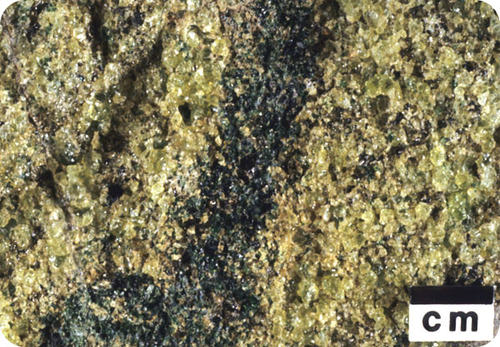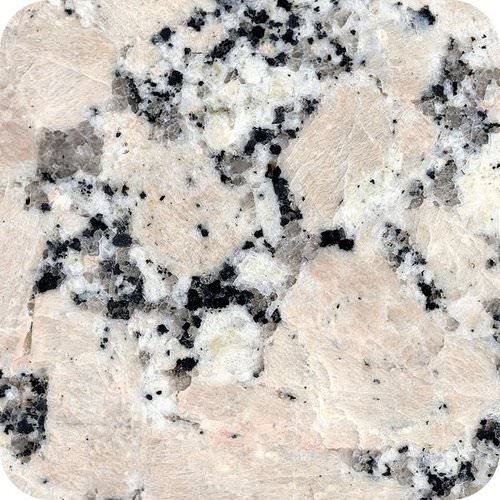READ: Igneous Rock Classification
READ: Igneous Rock Classification
Are these both igneous rocks?
These rocks don't even look like they're the same type, but they are both igneous! Igneous rocks cool from magma. The appearance of the rock is created by the composition of the magma and the rate that the magma cools. If the magma cools deep underground, it cools slowly. If the magma cools at or very near the surface, it cools quickly. This results in two different rock types. The rock types can be told apart by the size of their crystals.
Intrusive Igneous Rocks
Intrusive igneous rocks cool underground. Deep in the crust, magma cools slowly. Slow cooling gives crystals a chance to grow. Intrusive igneous rocks have relatively large crystals that are easy to see. Granite is the most common intrusive igneous rock. Pictured below are four types of intrusive rocks (figure below).
(A) This granite has more plagioclase feldspar than many granites. (B) Diorite has more dark-colored minerals than granite. (C) Gabbro. (D) Peridotite contains olivine and other mafic minerals.
Extrusive Igneous Rocks
Extrusive igneous rocks form above the surface. The lava cools quickly as it pours out onto the surface (figure below). Extrusive igneous rocks cool much more rapidly than intrusive rocks. The rapid cooling time does not allow time for large crystals to form. So igneous extrusive rocks have smaller crystals than igneous intrusive rocks. Extrusive igneous rocks are also called volcanic rocks.
(A) Lava cools to form extrusive igneous rock. The rocks here are basalts. (B) The strange rock formations of Chiricahua National Monument in Arizona are formed of the extrusive igneous rock rhyolite.
Some extrusive igneous rocks cool so rapidly that crystals do not develop at all. These form a glass, such as obsidian. Others, such as pumice, contain holes where gas bubbles were trapped in the lava. The holes make pumice so light that it actually floats in water. The most common extrusive igneous rock is basalt. It is the rock that makes up the ocean floor. Shown below are three types of extrusive igneous rocks (figure below).
Composition
Igneous rocks are also classified based on composition. Different igneous rocks contain minerals with different compositions. Mafic igneous rocks contain mafic minerals. Mafic minerals are dense and dark in color. They typically contain iron and magnesium; they are low in silica. Olivine and pyroxene are mafic minerals.
Olivine is the green mineral, pyroxene is the black mineral.
Felsic igneous rocks contain felsic minerals. They typically contain aluminum and sodium; they are high in silica. Quartz and potassium feldspar are felsic minerals. Minerals and rocks with a composition in between mafic and felsic are called intermediate.
Potassium feldspar is the pink mineral, plagioclase feldspar is the white mineral, and quartz is the gray mineral.
Igneous rocks are first classified by their composition, from felsic to ultramafic. The characteristics are included below.
Igneous Rock Compositions
| Composition | Color | Density |
|---|---|---|
| Felsic | Light | Low |
| Intermediate | Intermediate | Intermediate |
| Mafic | Dark | High |
| Ultramafic | Very dark | Very high |
Igneous rocks are also classified based on their silica content. Silica is found in minerals such as quartz.
| Type | Amount of Silica |
|---|---|
| Ultramafic | <45% |
| Mafic | 45-52% |
| Intermediate | 52-63% |
| Intermediate-Felsic | 63-69% |
| Felsic | >69% SiO2 |
Summary
- Magma cools to form igneous rocks. Two factors determine what type of rock forms.
- The composition of the magma determines if the rock is mafic, felsic, or intermediate.
- The rate the magma cools determines the texture of the rock.

